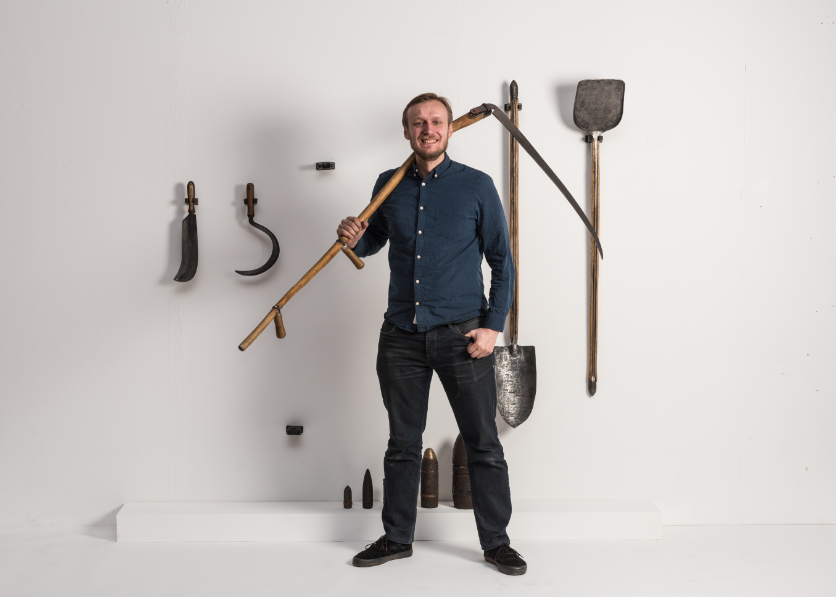9 Questions with Leszek Sikon - Magazine Issue02
Leszek Sikon is a London based artist featured in Al-Tiba9 magazine ISSUE02, interviewed by Mohamed Benhadj about his sculpture production SHELL TOOLS.
Making hand-forged knives and custom objects in only the highest quality materials are the core of Leszek Sikon’s practice, precision in craft is fundamental. Forging is an incredible process of transformation that allows him to create an artwork from any piece of available steel. Material culture is also crucial to his practice; the right piece of stock, with the right history, can reinforce the message his artwork attempts to convey.
At what point did you first realize that you could make a career out of your sculptures?
I came to the United Kingdom 12 years ago looking for work, managed to find one quickly and after couple years I managed to become a manager in one of the shops in London, I was earning decent money but this work did not satisfy me, every day was almost the same and that had made me feel exhausted. So 5 years ago I decided to go back to education. I was looking for a place that I can work with my hands and make something that would last, it was pure chance that I stumbled on the Hereford College Artist Blacksmith course. After attending the open day and having my first experience in forging I decided that this is what I want to do from now, I handed my notice to my manager and started my education.
What kind of education or training helped you develop your skillset?
I’ve attended the Artist Blacksmith course at Hereford College of Arts where I finished my BA degree. I learned how to be a blacksmith under Adrian Legge, Peter Smith, Chris Blythman, Ambrose Burn, but most importantly Delyth Done who is working extremely hard as a lead tutor of my course.
Your work is about transforming tools of destruction into tools of creation through a cyclical process. What inspired this artistic expression?
A couple of years back I went to a blacksmith meet-up in Wojciechowo, Poland. There I have had the pleasure to meet other smiths, among them 85-year-old master Józef Kułak who told me about how after the war they used to make tools from any steel scrap they could find, among it old shells. That picked my interest and I started to read about it. It seems that this had happened for centuries; whenever the war started, fighting powers take church bells, large railings, gates, anything that was made out of steel and smelt it down to create weapons and ammunition. And after the war people would have to find the way to rebuild, good qualities tools and steel were hard to find so village blacksmiths would do their best to create them with what they could find.
According to your statement, modern designers don’t have many options to change the shape of a blade of the kitchenware that we use today since in most cases it is simply the most efficient. You redesign daily use tools to find a perfect balance between modern design and everyday practicality, in a way giving the tools another form of reality. Can you talk about this process?
As a blacksmith a big part of my practice is making my tools, I’m proud to say that most of my hand tools I use I made myself. Certain shapes perform better at certain tasks, the hammer or a knife need to have a certain shape and weight so you would not use more than necessary strength. For me, this is one of the beauties of hand tools I can go to a museum and recognize the tools of my trade immediately. But it does not mean that tools need to just perform their task well, I noticed that on couple occasion I would, even though they were still working well, discard tools that I made before and made myself a new set just because, as I become a better blacksmith, I could make them look better. It seems that the same applies to many of my friends in different fields. I enjoy working with tools that are good looking and I think I can make a better quality work thanks to those tools. This is why I decided to focus my practice on tool making. I want to deliver the best possible tools that would exceed in performance but will also look beautiful, so the people that would use them could make the best possible dishes, sculptures, etc.
What skills as a sculptor do you think have made you a success in your art career?
I’m not afraid to take chances, I moved when I was 20 to a different country to look for work, quite a well paid job to be a blacksmith and probably scared my tutors with my idea of forging old ammunition into tools.
Making the Shell Tools
Leszek Sikon
What are your favorite things about being an artist?
The community is what I like the most. I was able to meet many interesting people thanks to my sculptures and tools, every one of these meetings opens new possibilities for new interesting projects and collaborations.
What current projects are you working on?
At the moment I’m working on a couple of new lines of knives and some woodworking tools, and I started to design a new sculpture inspired by the book Stalingrad by Antony Beevor. It’s still a long way before it’s finished but I hope it to be better than my “Shell Tools”.
What is your favorite genre of music to listen to while working?
As you can imagine a blacksmith workshop is not the quietest place, I usually have BBC1 radio on, but once the power hammer and machines are on, you can’t hear it.
Do you have any upcoming shows or collaborations?
I’m working with a friend of mine that specializes in 3D printing on a new range of knives. I won’t go into details since it will spoil the surprise but I think they will be great. Also, I plan to work with a goldsmith that would help me with some gold inlaying on one of my “Leaf” series knives. Also, I’ll be a part of the Tower of London Good Food show, and Handmade in Kew later this year.















